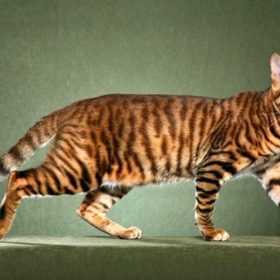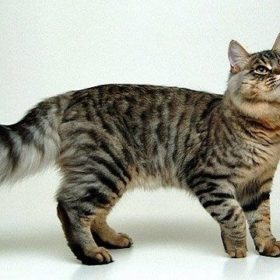LaPerm Shorthair

Gentleness and loyalty are the main features of the LaPerm Shorthair character. He is non-confrontational; aggression is not peculiar to him at all. The pet is very fond of the owner and spends a lot of time in his arms. The cat poorly tolerates loneliness. Be prepared to pay enough attention to your pet.
Table of Contents
Breed Information
| Origin | United States |
| Size | 22-28 cm |
| Weight | Males 4-6 kg Females 3-4 kg |
| Fur Type | Short-haired |
| Color | Anyone |
| Lifestyle | Outdoors, indoors |
| Lifespan | 10-14 years |
| FIFe Classification | – |
| WCF Classification | Group 3: “Short-haired” Breed designation – LPS |
| TICA Classification | LS |
| Group | Short-haired cats, rare cats |
| Price | $400-600 |
Breed Photos
Origin History
The breed traces its history back to 1982. The unusual pet was first discovered on a farm in Oregon. A domestic cat named Speedy was born with an almost bald kitten. After a couple of months, it developed a fuzzy coat. After crossing with other breeds, the same curly-haired offspring appeared. It indicated that the gene was dominant.
The cats of the new breed were first shown at a show in 1987. The standard of the LaPerm was adopted only eight years later. The International Cat Association developed it. Initially, the pet was known only in the USA, but gradually it gained worldwide popularity.
Appearance
Cats of this breed have a muscular and long body of medium size. The pet’s head is distinctive for its wedge-shaped shape and gentle contours. The muzzle is wide and moderately round. The forehead is flat, the transition to the nose is smooth. The neck is muscular and of medium length. The cat’s eyes are almond-shaped, set wide, color can be any.
Limbs of LaPerm Shorthair of medium length, front legs shorter than hind. The thick tail tapers toward the end. It is proportional to the body and resembles a bottle brush. The coat is short, light, and resilient. There are no color restrictions; it can be anything.
Character
Gentleness and loyalty are the main features of the LaPerm Shorthair character. He is non-confrontational; aggression is not peculiar to him at all. The pet is very fond of the owner and spends a lot of time in his arms. The cat poorly tolerates loneliness. Be prepared to pay enough attention to your pet.
LaPerm Shorthair has no problems adapting to new conditions. It easily tolerates a change of scenery and relocation. The cat loves to play with children and forgives them small pranks. The LaPerm Shorthair also has good compatibility with other animals. The exception is rodents and birds; at their sight, the cat awakens it’s hunting instinct.
Care
The LaPerm Shorthair does not require much space, and it will do well in a small apartment. If you decide to walk your pet, it’s best to use a leash and a flea collar. These precautions will reduce the risk of getting into trouble.
A short coat does not require frequent brushing. Do it once every one to two weeks with a metal brush. Do not bathe your pet more than once a month. Use mild baby shampoos for this purpose. Dry the cat without a hairdryer to avoid damaging its coat and skin. Periodically inspect the cat’s eyes and ears for clogs. If these are present, remove them with special products. Also, brush his teeth daily. Don’t forget to trim his claws every few weeks.
Education
This breed is sharp-minded and intelligent. You can easily train the LaPerm Shorthair to the scratching post and litter box. Walks on a leash, too; the pet will not object.
Get involved in fostering from an early age. This way, the cat is better adapted to the world around it. If you seriously decide to engage in training, make allowance for the shorthair’s soft and gentle nature. Stock up on patience and endurance. Never yell or raise your hand at your pet. It will make him very depressed. Replace the stick with a carrot and reward him with good food for his achievements.
Common Diseases
The LaPerm Shorthair has a strong immune system. He has no predisposition to genetic abnormalities. The only problem may be a tendency to obesity. Closely monitor the pet’s diet to avoid this problem.
Take your pet to the veterinarian regularly. Vaccinate and deworm your cat at the right time. Also, buy the cat a collar against parasites. With proper care and nutrition, the lapdog will live long enough.
Nutrition
You can feed your pet both natural food and dry food. Many experts prefer the second option. After all, the composition of food includes all the necessary nutrients.
If you turn to a natural diet, make sure that it is balanced. The basis of the cat’s diet should be lean meat. Such varieties as chicken, beef, and turkey will do. Meat products can be diluted with cereals and dairy products. But the source of vitamins and minerals will be vegetables, fruits, and herbs.
 Ural Rex Longhair
Ural Rex Longhair Kanaani
Kanaani Toyger
Toyger Ojos Azules
Ojos Azules Domestic Cat
Domestic Cat Seychellois Shorthair
Seychellois Shorthair


